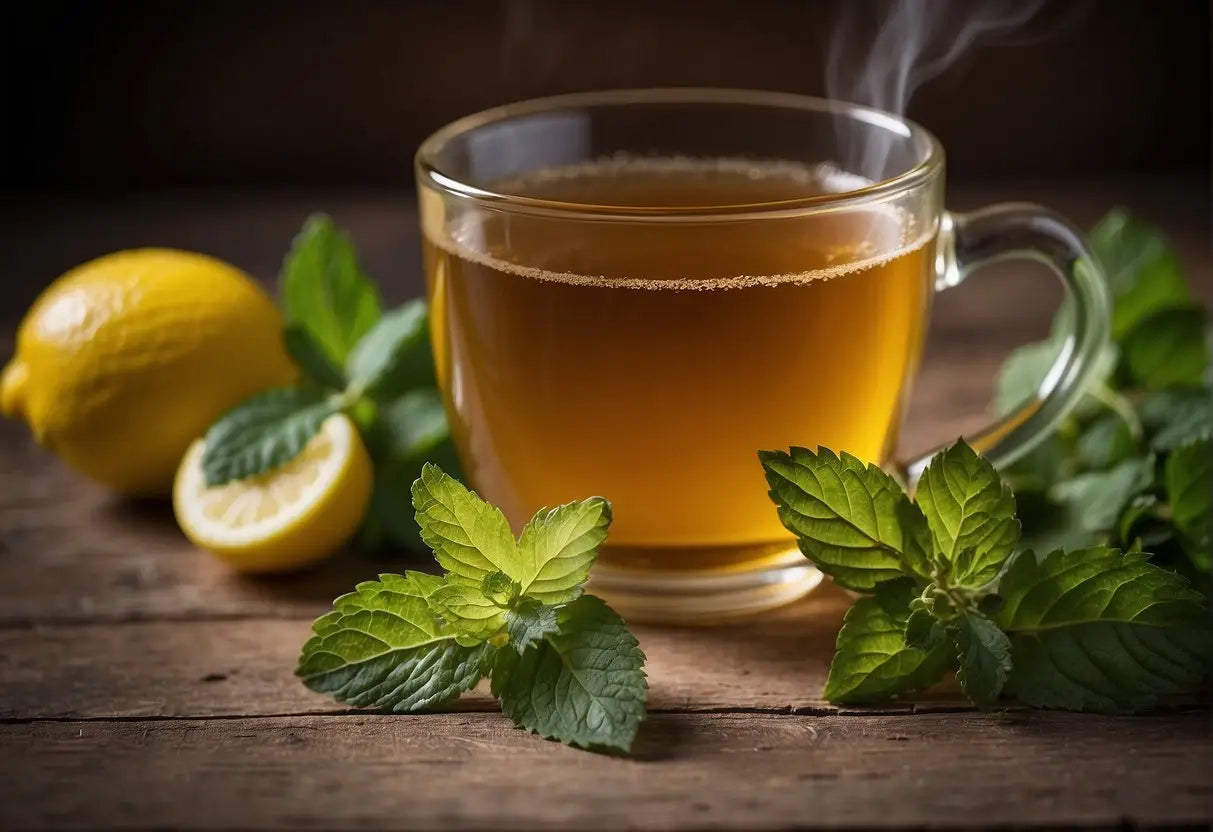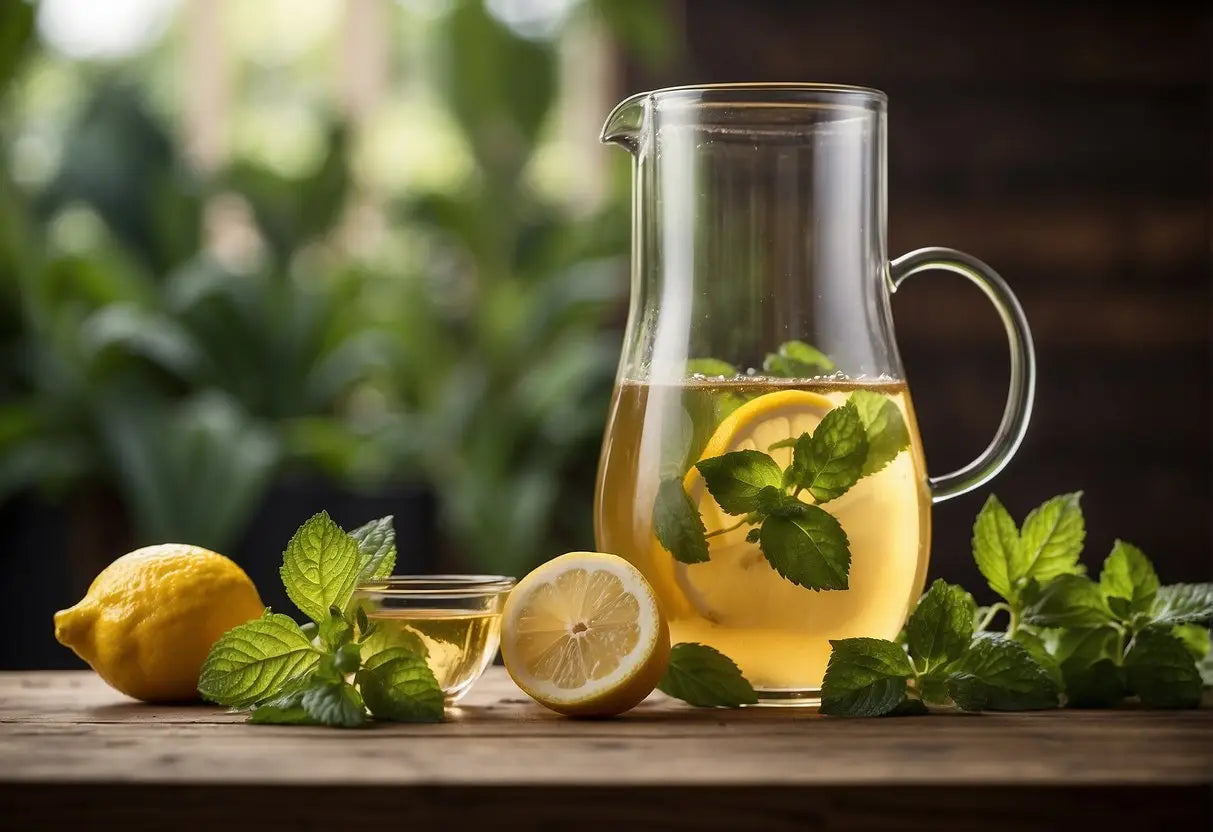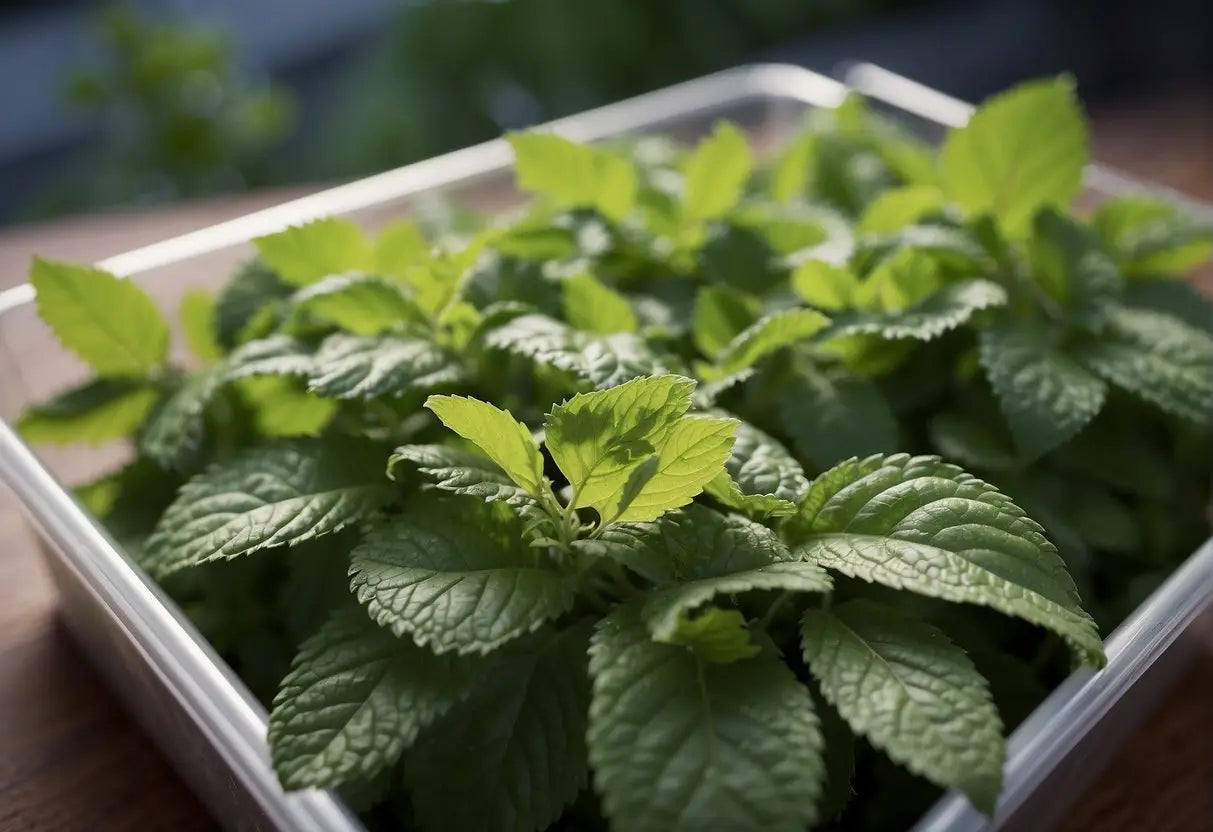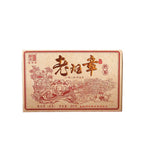Lemon Balm Tea Recipe
Lemon balm tea, made from the leaves of the Melissa officinalis plant, is known for its soothing properties. Drinking this herbal tea may offer several health benefits which can contribute to your overall well-being.
Stress Relief:
- You may find relief from stress and anxiety after consuming lemon balm tea. Its calming effects on the nervous system can help in promoting a sense of relaxation.
Improved Sleep:
Bestsellers
- If you struggle with sleep, lemon balm tea might be beneficial. It has traditionally been used to alleviate insomnia and improve sleep quality.
Digestive Health:
- Lemon balm tea can also aid in digestion. Its antispasmodic properties may help in relieving indigestion, bloating, and gas.
| Cognitive Boost | Antioxidant Properties |
|---|---|
| Lemon balm tea can enhance your cognitive function, with potential improvements in alertness and problem-solving skills. | The antioxidants in lemon balm can help protect your cells from oxidative stress, which is linked to numerous chronic diseases. |
Immune Support:
- Regular consumption may support your immune system due to its antibacterial and antiviral effects.
Remember, while lemon balm tea can be a calming and beneficial herbal remedy, it's important to consult with your healthcare provider before making it a regular part of your health regimen, especially if you are pregnant, nursing, or on medication.
Ingredient List

For preparing lemon balm tea, you will need the following ingredients:
-
Lemon Balm Leaves:
- Fresh: 1/4 cup (packed)
- Dried: 2 tablespoons
-
Water:
- 8 ounces (1 cup)
-
Sweetener (optional):
- Honey or sugar (to taste)
-
Additional Flavorings (optional):
- Lemon juice: 1 teaspoon
- Cinnamon stick: 1
To make the most of these ingredients, ensure you have the lemon balm leaves properly washed if fresh, and if using dried, confirm they are from a reputable source for the best quality. Use filtered water if possible for a purer taste. Sweeteners and additional flavorings are to your preference; honey can complement the lemon flavor nicely, while the cinnamon stick can be added for a hint of spice. Adjust the amounts based on your personal taste preference.
Required Tools and Utensils

To prepare lemon balm tea, you will need a few basic tools and utensils which are essential for the process.
Lao Ban Zhang
Teapot or Saucepan: This will be used to steep the lemon balm leaves in hot water. A ceramic or glass teapot is ideal, but any saucepan will work.
Measuring Cup: It's important to measure the right amount of water to ensure the proper concentration of your tea. Use a measuring cup for accuracy.
Strainer or Infuser: You will require a strainer to separate the leaves from the liquid after steeping. An infuser can be used if you prefer to steep the leaves within it.
Kettle: To boil the water. Electric kettles are fast and convenient, but a stovetop kettle or microwaveable container can also be used.
Tea Cups: Choose cups that will retain heat well for serving.
Spoon: For stirring and possibly for measuring out your lemon balm leaves if you do not have a measuring spoon.
Below is a checklist to ensure you have all the necessary items:
- Teapot or Saucepan
- Measuring Cup
- Strainer or Infuser
- Kettle
- Tea Cups
- Spoon
Before you begin making your tea, gather all of these tools and utensils to streamline the process.
Fresh Lemon Balm Tea Preparation

To craft a refreshing cup of lemon balm tea, you'll need fresh leaves and the right technique. Follow this straightforward process to achieve a soothing, aromatic beverage.
Harvesting Lemon Balm Leaves
Choose healthy, vibrant green leaves from your lemon balm plant. Early morning is ideal, after the dew has evaporated and before the sun is fully intense. Using scissors, snip off just the amount you need, typically a handful for a pot of tea.
Washing and Prepping the Leaves
- Rinse the leaves under cold water to remove any dirt or impurities.
- Pat them dry with a clean towel gently.
- If desired, chop the lemon balm leaves coarsely to release more oils and enhance the flavor of your tea.
Brewing Method
To brew your tea:
- Place about 1/4 cup of fresh lemon balm leaves in a teapot.
- Boil 1 cup of water and pour it over the leaves.
- Cover the teapot and steep for 5 minutes. For a stronger tea, steep up to 10 minutes.
- Strain the tea into a cup, pressing on the leaves to extract flavor.
Serving Suggestions
- Serve your lemon balm tea hot, as is, or with a sweetener like honey or sugar as preferred.
- For a cooler refreshment, let the tea cool down and pour over ice cubes in a tall glass.
Use these simple steps to make a cup of lemon balm tea that’s both fragrant and flavorful. Enjoy your homemade herbal infusion.
Dried Lemon Balm Tea Preparation

To create a soothing cup of lemon balm tea from dried leaves, you'll need to prepare the leaves properly, store them to maintain their quality, and understand the steeping technique. Each step is critical for a delightful tea experience.
Drying Lemon Balm Leaves
Start by gathering fresh lemon balm leaves in the morning after the dew has evaporated. Spread the leaves out on a clean, dry surface in a well-ventilated area away from direct sunlight. Allow them to air dry for several days until they crumble when pressed between your fingers. Alternatively, you can use a dehydrator set at 95-115°F (35-46°C) for 1-4 hours, checking periodically.
Storing Dried Leaves
Once dried, store your lemon balm leaves in an airtight container, away from light and moisture. Glass jars with tight-fitting lids or vacuum-sealed bags are ideal options. Label the container with the date of drying to keep track of freshness.
Steeping Process
To steep the tea:
- Measure: Use about 1-2 teaspoons of dried lemon balm leaves per cup of water.
- Boil Water: Heat water to just below boiling, around 200°F (93°C).
- Steep: Place the leaves in the water and let them steep for 5-10 minutes, depending on desired strength.
Strain the leaves from the tea using a fine mesh strainer before serving.
Flavor Enhancements
Enhance the flavor of your tea with these additions:
- Sweeteners: Honey or sugar can be added for sweetness.
- Citrus: A slice of lemon adds a refreshing twist.
- Mint: A few fresh mint leaves can provide an extra layer of flavor.
Experiment with combinations to find your perfect cup.
Cold Brew Lemon Balm Tea Methodology

To make cold brew lemon balm tea, follow these simple and precise steps for a refreshing beverage:
Ingredients:
- Fresh lemon balm leaves: 1/2 cup
- Cold water: 4 cups
- Optional: Honey or sweetener of your choice
Instructions:
-
Prepare the Leaves:
- Gently rinse your lemon balm leaves under cold water to remove any debris.
- Pat them dry with a clean towel.
-
Infuse:
- Place the lemon balm leaves into a pitcher or jar.
- Pour the cold water over the leaves, ensuring they are fully submerged.
-
Refrigeration:
- Seal the pitcher with a lid or cover it with plastic wrap.
- Place it in the refrigerator for at least 4 hours, though for a more robust flavor, let it steep overnight.
-
Strain:
- After the steeping time, strain the lemon balm leaves from the water using a fine mesh sieve or cheesecloth.
-
Serve:
- Pour the tea over ice if desired.
- Add honey or your choice of sweetener to taste.
Note: If you prefer a stronger infusion, you may add more leaves or extend the steeping time. For a milder flavor, reduce the amount of lemon balm or steep for a shorter period. Enjoy your cold brew lemon balm tea chilled for the best experience.
Duration and Temperature for Optimal Steeping
When brewing lemon balm tea, temperature and duration are critical factors to extract the ideal flavor and therapeutic properties effectively. Use the following guidelines to achieve the best result:
Temperature
Start with freshly boiled water at approximately 200°F (93°C). If you don’t have a thermometer, boil the water and let it rest for about 1 minute to reach the suggested temperature.
Steeping Duration
For a potent brew:
- Place 1 to 2 teaspoons of dried lemon balm leaves into your cup or teapot.
- Pour the heated water over the leaves.
- Steep the tea for 5 to 10 minutes.
| Steeping Time | Strength |
|---|---|
| 5 minutes | Mild Flavor |
| 10 minutes | Strong Flavor |
Adjust the time based on your personal preference for the strength of the tea.
Keep the teapot or cup covered during steeping to preserve the oils and aromatic compounds. This action ensures that the essence of the herb infuses effectively into the water, providing a more flavorful and aromatic tea.
Remember not to steep the leaves for too long as it may result in a bitter taste. If you wish for a lighter flavor, simply reduce the steeping time. Experimenting with the steeping duration will allow you to find your perfect balance for a satisfying cup of lemon balm tea.
Lemon Balm Tea Variations

Exploring variations to the classic lemon balm tea can enhance your tea experience with new flavors and benefits. Each adjustment offers a unique twist to your soothing cup.
Combining with Other Herbal Teas
You may combine lemon balm with other herbal teas to create a blend suited to your taste and health goals. Here are popular options:
- Chamomile: Known for its calming properties, chamomile pairs well with lemon balm for a relaxing bedtime tea.
- Peppermint: Add peppermint to lemon balm tea for a refreshing flavor and digestive benefits.
- Lavender: For a soothing aroma and stress relief, mix in some lavender with lemon balm.
Sweetening Agents
Selecting a sweetener for your lemon balm tea can affect both taste and healthfulness. Consider these natural sweeteners:
- Honey: A spoonful of honey not only sweetens your tea but also brings its own antibacterial properties.
- Maple Syrup: A dash of maple syrup can add a woodsy sweetness and is a vegan alternative.
- Stevia: If you're watching your sugar intake, stevia is a calorie-free sweetener that derives from a natural source.
Citrus Infused Lemon Balm Tea
Incorporating citrus into your lemon balm tea can brighten the flavor and add a boost of vitamin C. Here's how:
- Lemon Zest: Grate fresh lemon zest directly into your tea for a zesty kick.
- Orange Slices: Add a few fresh orange slices to the tea while steeping for a subtle, sweet citrus infusion.
- Lime Juice: Squeeze in some fresh lime juice to bring a tangy twist to your lemon balm tea.
Potential Side Effects and Interactions

Lemon balm tea is widely consumed for its calming effects and pleasant taste. However, like many herbal remedies, it may cause side effects in some individuals and interact with certain medications.
Side Effects: While generally safe for most people, lemon balm tea, especially in high doses, could lead to the following side effects:
- Digestive issues: Such as nausea or abdominal pain.
- Headache: Some individuals might experience headaches.
- Dizziness: Especially if consumed in large amounts.
- Allergic reactions: Rare but possible, including symptoms like swelling, hives, or difficulty breathing.
Interactions:
Lemon balm may interact with a variety of medications and substances. Be cautious if you're taking:
| Medication Type | Potential Interaction |
|---|---|
| Sedatives | Lemon balm has a sedative effect and may cause excessive drowsiness when taken with other sedative medications, like benzodiazepines or some antidepressants. |
| Thyroid medications | As lemon balm may affect thyroid function, it could alter the effectiveness of thyroid medications. |
| HIV medications | Lemon balm may interfere with the body's absorption of these drugs. |
| Anticoagulants | There's a potential risk of increased bleeding if lemon balm is taken with blood thinners due to its possible effect on blood clotting. |
Always consult your healthcare provider before adding lemon balm tea to your routine, especially if you have any pre-existing conditions, are pregnant, breastfeeding, or taking any medications.
Lemon Balm Tea Preservation Techniques

When preserving lemon balm tea, your methods will affect the longevity and flavor of the tea. The following techniques will ensure that you maximize the shelf life and quality:
Drying Lemon Balm Leaves:
- Gather fresh lemon balm leaves.
- Rinse to remove any dirt.
- Pat leaves dry gently with a clean towel.
- Spread the leaves on a drying rack in a well-ventilated area.
- Allow to air dry, avoiding direct sunlight, for 1-2 weeks.
- Store dried leaves in an airtight container.
Freezing Lemon Balm Leaves for Tea:
- Rinse and dry the lemon balm leaves as described above.
- Place leaves in a single layer on a baking sheet.
- Freeze until solid, then transfer to airtight freezer bags.
- Use directly from the freezer when brewing tea.
Storing Brewed Lemon Balm Tea:
- Brew your tea and let it cool to room temperature.
- Pour into a glass container, leaving some space at the top if you plan to freeze it.
- Refrigerate for up to 5 days or freeze for up to 6 months.
Remember:
- Label your storage containers with the date of preservation to keep track.
- Always check for any signs of spoilage such as mold or off-odors before use.
- For best results, use dried or frozen lemon balm within a year.
← Older post Newer post →











